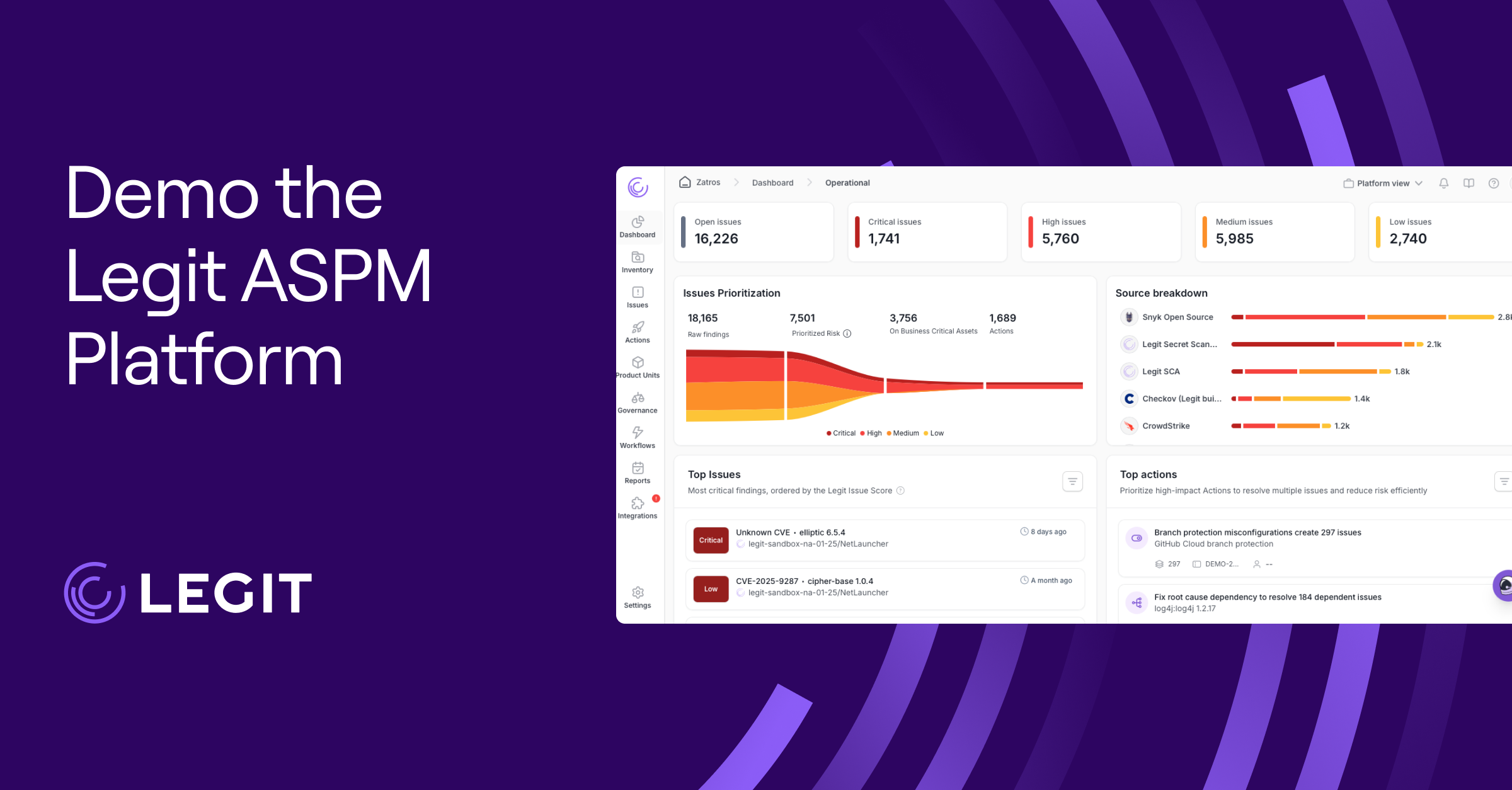Enterprise applications sit at the center of business operations, which means they’re prime targets for attackers looking to exploit vulnerabilities. With threats ranging from supply chain compromises to identity attacks and data breaches, patchwork defenses aren’t enough to fully protect core systems.
Enterprise application security demands a comprehensive approach that combines preventative controls and strong governance to protect sensitive data and keep mission-critical systems resilient. Read on to discover what’s necessary for bolstering your enterprise security system against today’s biggest challenges.
What Is Enterprise Application Security?
Enterprise application security is the practice of protecting large-scale, business-critical software systems—including web-based platforms, APIs, and third-party integrations—against threats that evolve across the software development lifecycle (SDLC).
These security environments are complex by design, including open-source dependencies and multi-cloud infrastructure to safeguard the business’s vital software. Organizations often turn to enterprise application security services to navigate this complexity and ensure comprehensive protection.
Proactive security goes beyond scanning a single app for bugs. It’s about embedding protection at every layer, enforcing security defaults through the most secure coding practices, and maintaining control over how teams build and access applications.
Achieving this depth of protection requires a consistent framework that scales with your architecture. This means integrating identity and access controls, secrets management, and enterprise application security testing directly into the developer workflow.
Traditional web application security best practices still apply, but enterprise environments demand broader context and a unified approach to risk reduction at depth. New solutions for contemporary security problems, such as application security posture management (ASPM), create a shared foundation at enterprise scale that adapts to modern DevSecOps pipelines while maintaining visibility and governance.
Enterprise Application Security Best Practices
Enterprise environments are high-value targets for bad actors, which means security needs to be proactive and built to scale. Here are some best practices that form the backbone of any solid enterprise application security checklist and should be integrated throughout the application development process.
Use ASPM to Correlate SAST, DAST, and SCA Findings
Static application security testing (SAST), dynamic application security testing (DAST), and software composition analysis (SCA) tools each uncover different types of vulnerabilities—from insecure code to runtime flaws. But in enterprise environments, these findings are often fragmented and hard to act on. ASPM brings these signals together, maps them to your environment, and prioritizes the highest-risk vulnerabilities—similar to how a security information and event management (SIEM) platform correlates runtime logs to spot real threats—so you can focus on what matters most.
Conduct Regular Security Audits
Security audits can catch misconfigurations, missing security patches, and policy drift before attackers do. By reviewing your app portfolio on a recurring basis—ideally with automated tools and threat modeling—you can flag weaknesses that accumulate over time. Application risk assessments are particularly useful in security audits, enabling risk-based vulnerability management so you can focus on the most pressing exploitable threats.
Keep Redirect URIs Up to Date
Redirect URIs control where your app sends users after authentication, and they’re a common target for hijacking. Keep the list tight, use HTTPS exclusively, and avoid wildcards that can open unintended access. If your domain structure changes, update the URI configurations right away to prevent authentication bypass and man-in-the-middle attacks.
Implement Multi-Factor Authentication
Requiring multi-factor authentication (MFA) is one of the fastest ways to safeguard enterprise apps against unauthorized access. It’s important to enforce MFA for both users and admins and integrate it with role-based access controls (RBAC). MFA shouldn’t just apply at login, either—trigger it for sensitive actions like changing app configuration or issuing credentials.
Use Managed Identities and Secure Credential Handling
Applications often need authentication during CI/CD workflows or when accessing APIs. Whenever possible, use managed identities instead of long-lived credentials. Managed identities are tied to the platform, easy to rotate, and eliminate a major attack surface.
If you must use certificates, store them in a secure vault and rotate them regularly. Never commit credentials to source control. This secure coding practice is important in DevSecOps environments where automation is the norm and speed can’t come at the cost of security.
Lock Down Application Permissions
Always follow the principle of least privilege and only grant permissions needed for the app’s function. Use delegated access over app-only access where you can, and regularly prune access that’s no longer necessary. Managing who has permission within your system builds confidence that every person working on your app is doing exactly what they’re supposed to do and nothing more.
Define and Protect Your Application URIs
The application ID URI uniquely identifies your app in token requests. If your application URIs are misconfigured, they can allow attackers to spoof access tokens and collide with another app’s permissions. Stick to recommended api://<appID> or verified custom domain formats. Don’t use wildcards and make sure your URIs are unique across the tenant for maximum enterprise web application security.
Assign and Review Application Ownership
Every app in your environment should have a known accountable owner. This ensures someone is responsible for maintaining configurations, reviewing permissions, and addressing issues when they arise. Review ownership lists regularly so nothing falls through the cracks.
Enterprise Application Security Importance
Enterprise application environments are massive and messy, with sprawling codebases, fast-moving teams, and multiple apps running across multiple types of legacy infrastructure. That scale breeds complexity, and complexity creates opportunity for mistakes and attacks. Enterprise application security exists to cut through that chaos and systematically reduce risk across the entire SDLC.
Unlike smaller organizations, enterprises have to defend a much larger attack surface, coordinating security and compliance across distributed teams against risks like shadow IT, zombie APIs, and inconsistent tooling. Successful enterprise security makes sure every team can build and ship secure applications without leaving a door open. Done right, enterprise AppSec builds trust into every layer and scales security as quickly as the business grows.
4 Common Enterprise Application Security Challenges
Securing one app is hard enough. Doing it across dozens of teams, tools, and environments? That’s where the real challenges—like these four—show up.
1. Protecting the Entire Application Lifecycle
Enterprise applications aren’t built and forgotten. They evolve constantly, and so do their risks. Securing enterprise apps means looking beyond code scans to catch issues like dependency choices and product misconfigurations from the earliest design decisions to runtime. Without full lifecycle visibility, it’s easy to miss risk sources.
2. Navigating Complex Security and Compliance Governance
Enterprise teams need to meet internal policies, customer expectations, and regulatory frameworks like the General Data Protection Regulation (GDPR) or the Health Insurance Portability and Accountability Act (HIPAA). The juggle of rules and regulations can create a governance challenge when different teams use different tools or standards in their pipelines. Aligning security practices across the organization requires shared expectations and active accountability.
3. Prioritizing What to Fix
Enterprise-scale scanning can generate thousands of security vulnerabilities, but only a fraction of those alerts represent real risk. Risk-based prioritization needs to consider exploitability, exposure, and business impact—not just severity scores. Without clear prioritization in an enterprise application security framework, teams waste time on noise while real threats slip through.
4. Scaling Security Across Distributed Teams
It’s one thing to secure a single app. It’s another thing entirely to apply consistent controls across dozens (or hundreds) of services owned by different teams in different regions who all ship code on different schedules. Security needs to scale like the business—with automation, context, and policies that work at enterprise speed.
Protect Your Enterprise Application Security With Legit Security
Legit Security helps enterprises secure every phase of the SDLC, from initial code commits to productive deployment, without slowing teams down. Legit’s ASPM solution connects across the product lifecycle to uncover risks in code, pipelines, infrastructure, and third-party components, then prioritizes what makes the biggest impact on your business.
With out-of-the-box policy enforcement and deep integrations into developer workflows, Legit turns fragmented AppSec efforts into coordinated security solutions. Whether you’re securing dozens of apps or hundreds, Legit gives you the context and control to scale security with your business.
Ready to take a smarter approach to enterprise application security? Request a demo today.
Download our new whitepaper.


